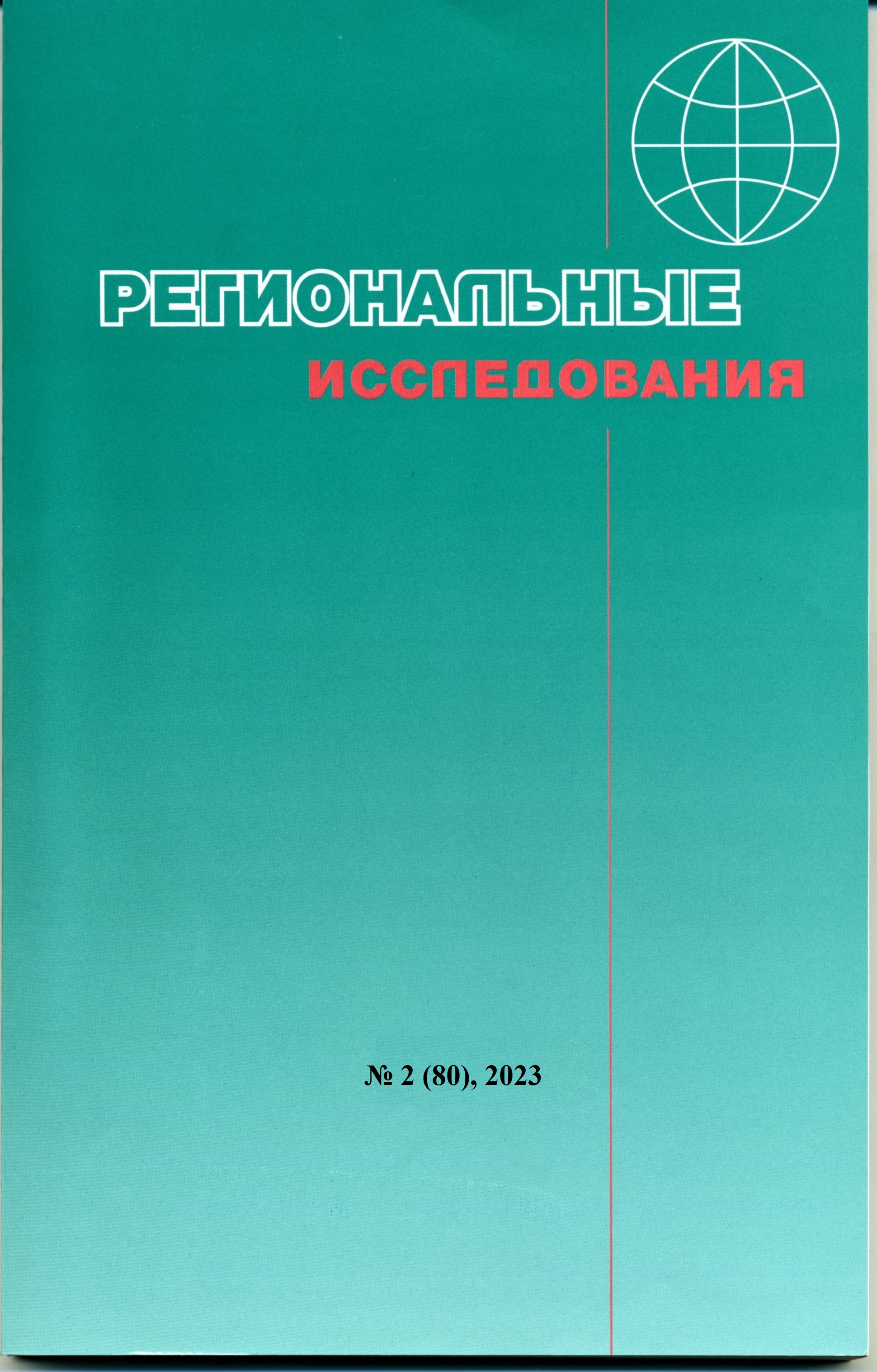Antonov E.V., Bityukova V.R. Approaches to the anthropogenic impact assessment at municipal level (the case of Baikal natural territory)
DOI:
https://doi.org/10.5922/1994-5280-2023-2-5Keywords:
municipalities, urban and rural settlements, Baikal, central ecological zone, integral assessment, anthropogenic impactAbstract
The article substantiates a system of indicators for assessing the anthropogenic impact at the level of municipalities, taking into account the specifics of the Baikal Natural Territory (BNT). It also help to asses estimated indicators for the level of individual settlements in the central ecological zone of the BNT. The structure of the integral indicator reflects the components of the spatial distribution of the anthropogenic pressure that made it possible to carry out an appropriate typology of the municipal districts of the BNT. Calculation of indicators that are absent in official statistics for the level of settlements was conducted on the basis of data on the population and vehicle fleet using GIS technologies which made it possible to assess the anthropogenic impact in urban districts, municipal districts and rural settlements of the central ecological zone. A general decrease in most environmental indicators of anthropogenic impact was revealed. It was also revealed that gradual alignment of territorial proportions is present when the localization of impact in individual municipalities in 2014–2020. The use of the integral index of anthropogenic impact made it possible to assess trends in the ecological zones of the BNT. The level of impact in the central zone varies the most across the territory and seasons, in the buffer zone there are contrasts between socio-economically close areas, and in the zone of atmospheric influence the impact is concentrated in the largest cities. A gradual weakening of the role of industrial specialization in the formation of the ecological situation as well as a simplification of the structure of types of impact within the regions are shown. However, two significant areas of impact on Baikal (Irkutsk and South Buryat) remain stable. The main changes occur in the group of regions with a medium level of anthropogenic impact as a result of the implementation of major infrastructure projects.
Financing
The work was carried out within the framework of the Research and Development Center of Moscow State University of the Department of Economic and Social Geography of Russia No. 121051100161-9 "Modern Dynamics and Factors of Socio-Economic Development of Regions and Cities of Russia and the Near Abroad."
References
Айвазян С.А. Анализ качества и образа жизни населения. Эконометрический подход. М.: Наука, 2012. 432 с.
Антонов Е.В., Беляев Ю.Р., Битюкова В.Р., Бредихин А.В., Дехнич В.С., Еременко Е.А., Колдобская Н.А., Прусихин О.Е., Сафронов С.Г. Интегральная оценка антропогенного воздействия на Байкальской природной территории: методические подходы и типология муниципальных районов // Изв. РАН. Сер. геогр. 2023. № 3. С. 1–18.
База данных показателей муниципальных образований. Охрана окружающей среды Федеральная служба государственной статистики (Росстат), 2017. [Электронный ресурс]. URL: http://www.gks.ru (дата обращения 08.07.2022).
База данных Росприроднадзора (Федеральная служба по надзору в сфере природопользования). [Электронный ресурс]. URL: http://rpn.gov.ru/opendata (дата обращения 08.07.2022).
Байкальский регион: общество и природа. Атлас. Изд-во: Паулсен, 2021. 320 с.
Битюкова В.Р. Экологический рейтинг регионов России. Ежегодник Русского географического общества / под ред. Н.С. Касимова. М.: Эксмо, 2021. 336 с.
Ветров Г.Ю., Визгалов Д.В., Шанин А.А., Шевырова Н.И. Индикаторы социально-экономического развития муниципальных образований. М.: Фонд «Ин-т экономики города», 2002. 65 с.
Владимиров И.Н., Корытный Л.М., Плюснин В.М., Сороковой А.А. Исследования Института географии им. В.Б. Сочавы СО РАН на Байкальской природной территории // География и природные ресурсы. 2016. № S5. С. 6–14.
Воробьевская Е.Л., Кириллов С.Н., Слипенчук М.В., Тульская Н.И., Устьянцев А.В., Цымбал М.Н. Оценка влияния Холоднинского полиметаллического месторождения на водные объекты Северного Прибайкалья // Экология и промышленность России. 2018. Т. 22 № 12. С. 68–73.
Государственный доклад «О состоянии озера Байкал и мерах по его охране в 2020 году». Иркутск: Ин-т географии им. В.Б. Сочавы СО РАН, 2021. 360 с.
Евстропьева О. В. Развитие туристской системы на Байкальской природной территории // География и природные ресурсы. 2016. № 5. С. 184–195.
ЕМИСС Государственная статистика. [Электронный ресурс]. URL: https://www.fedstat.ru/ indicator/36702 (дата обращения: 15.06.2022).
Землянский Д.Ю., Калиновский Л.В., Махрова А.Г., Медведникова Д.М., Чуженькова В.А. Комплексный индекс социально-экономического развития городов России // Изв. РАН. Сер. геогр. 2020. № 6. С. 805–818.
Игенбаева Н.О. Антропогенная трансформация лесостепных ландшафтов Омского Прииртышья: дисс. … канд. геогр. наук: 25.00.23 / Алт. гос. ун-т. Барнаул, 2006. 216 с.
Информационный ресурс «Экологический мониторинг озера Байкал» [Электронный ресурс]. URL: http://www.baikalake.ru/about/uvpn/ (дата обращения: 26.02.2022).
Касимов Н.С., Битюкова В.Р., Малхазова С.М., Кошелева Н.Е., Никифорова Е.М., Шартова Н.В., Власов Д.В., Тимонин С.А., Крайнов В.Н. Регионы и города России: интегральная оценка экологического состояния / под ред. Н.С. Касимова. М., 2014. 560 с.
Кириллов П.Л., Махрова А.Г. Опыт типологии региональных систем городского расселения России // Региональные исследования. 2020. № 1. С. 4–15.
Кропянко Л.В. Геоэкологическая оценка и районирование Азово-Черноморского побережья России: дисс. … канд. геогр. наук: 25.00.36 / Юж. федер. ун-т. Ростов-на-Дону, 2014. 216 с.
Кузнецова О.В., Бабкин Р.А. Типология муниципальных образований для мониторинга их социально-экономического развития // Федерализм. 2021. Т. 26. № 4 (104). С. 35–53. DOI: 10.21686/2073-1051-2021-4-35-53.
Ромашина А.А. Типология муниципальных образований России по специализации экономики и положению в системе расселения // Региональные исследования. 2019. № 3. С. 42–52.
Рыбкина И.Д. Оценка экологической опасности в системах расселения Алтайского края: дисс. … канд. геогр. наук: 25.00.36 / Ин-т вод. и экол. проблем СО РАН. Барнаул, 2005. 227 с.
Саприн С.В. Оценка экологической устойчивости агроландшафтов Воронежской области: дисс. … канд. геогр. наук: 25.00.26 / Гос. ун-т по землеустройству. М., 2017. 156 с.
Угарова Н.А. Новый подход к оценке изменения устойчивости городской среды на примере городов Челябинской области // Экология и промышленность России. 2004. № 10. С. 4–9.
Федеральный закон от 01.05.1999 N 94-ФЗ (ред. от 30.12.2021) «Об охране озера Байкал». 26 с. [Электронный ресурс]. URL: https://docs.cntd.ru/document/901732256 (дата обращения:15.06.2022).
Экологический атлас бассейна озера Байкал. Иркутск: Изд-во ИГ СО РАН, 2015. 145 с.

